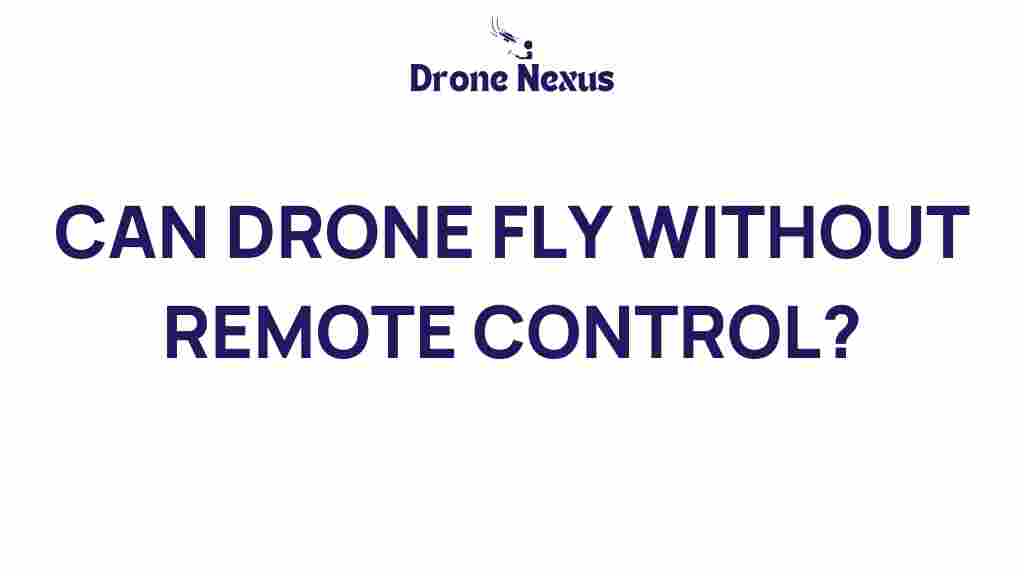Can Drones Fly Without Remote Control? Discover the Future of Autonomous Flight
In recent years, the evolution of drones has captivated the imagination of technologists, hobbyists, and businesses alike. As we venture deeper into the era of automation, one question looms large: can drones fly without remote control? This article delves into the future of autonomous flight, exploring how drones are becoming increasingly self-sufficient and the implications of this technological advancement.
The Rise of Autonomous Drones
Autonomous drones are aircraft that can operate independently of human intervention. These drones utilize advanced technology such as artificial intelligence (AI), machine learning, and sophisticated sensors to navigate and complete tasks. The rise of autonomous drones is transforming various industries, including agriculture, logistics, and surveillance.
How Do Autonomous Drones Work?
Understanding how autonomous drones function is essential to appreciate their capabilities. Here’s a breakdown of the technology behind them:
- GPS Navigation: Most drones utilize GPS for precise location tracking and navigation. This allows them to fly predetermined routes without manual control.
- Obstacle Detection: Equipped with sensors such as LiDAR and cameras, autonomous drones can detect and avoid obstacles in real-time, ensuring safe flight.
- Data Processing: Onboard computers process data from various sensors to make flight decisions, enabling the drones to adapt to changing environments.
- AI and Machine Learning: These technologies allow drones to learn from previous flights, improving their performance over time.
Applications of Autonomous Drones
The capabilities of autonomous drones have led to their adoption in numerous fields:
- Agriculture: Farmers use drones for crop monitoring, soil analysis, and even precision spraying of pesticides and fertilizers.
- Logistics: Companies like Amazon are exploring the use of drones for package delivery, promising faster delivery times and reduced costs.
- Surveillance: Autonomous drones are employed for security and surveillance, providing real-time data without the need for a pilot.
- Search and Rescue: In emergencies, drones can cover vast areas quickly, identifying missing persons and assessing disaster damage.
Can Drones Operate Without Human Input?
Now that we understand the technology behind autonomous drones, it’s essential to address the core question: can drones truly operate without human input? The answer is a resounding yes, with certain conditions and limitations.
Fully Autonomous Operations
Many drones are designed to perform fully autonomous operations. These drones can take off, navigate, and land without requiring a remote control. They rely on pre-programmed flight paths or real-time decision-making capabilities. For instance:
- Delivery Drones: These drones can autonomously deliver packages from warehouses to customers, following optimized routes.
- Survey Drones: Used in land surveying, these drones can autonomously map large areas, gathering data without human oversight.
Limitations of Autonomous Drones
Despite their advanced capabilities, autonomous drones do have limitations:
- Regulatory Constraints: Many regions have strict regulations governing drone flights, often requiring a human pilot to oversee operations.
- Technical Failures: Autonomous drones can experience technical issues that may require human intervention for troubleshooting.
- Complex Environments: In complicated or rapidly changing environments, drones may struggle to make real-time decisions without human input.
The Future of Drones: A Hybrid Approach
While fully autonomous operations are a reality, the future of drones may lie in a hybrid approach—combining autonomous technology with human oversight. This can enhance safety and efficiency, especially in complex scenarios.
Step-by-Step Process: Programming an Autonomous Drone
Programming an autonomous drone can be a straightforward process. Here’s a step-by-step guide:
- Choose the Right Drone: Select a drone equipped with autonomous capabilities and the necessary sensors for your specific application.
- Install Software: Use appropriate flight planning software to set up the drone’s flight parameters.
- Define Flight Path: Create a flight path using GPS waypoints, ensuring the route is clear of obstacles.
- Conduct Pre-Flight Checks: Before launching, ensure all systems are functioning correctly and that the drone is in optimal condition.
- Launch the Drone: Initiate the autonomous flight mode, allowing the drone to execute the programmed mission.
- Monitor the Flight: Even with autonomous capabilities, monitor the flight in real-time for any potential issues.
- Data Analysis: After the flight, analyze the data collected to assess the performance and outcomes.
Troubleshooting Tips for Autonomous Drones
Even the most advanced autonomous drones can encounter issues. Here are some common problems and how to troubleshoot them:
- Loss of GPS Signal: If the drone loses GPS signal, it may revert to manual control. Ensure you are flying in an area with a clear sky.
- Battery Failure: Always check the battery status before flight. If the battery is low, do not take off.
- Software Glitches: Keep the drone’s firmware updated. Reboot the drone if you encounter unexpected behavior.
- Obstacle Collision: If the drone fails to detect an obstacle, ensure that all sensors are clean and functioning properly.
Conclusion: The Future of Drones is Autonomous
As technology continues to advance, the potential for drones to operate autonomously without remote control is becoming increasingly viable. With applications spanning various industries, these self-flying machines are set to revolutionize the way we operate in the skies. While challenges remain, the future looks bright for autonomous drones.
For those interested in exploring more about drones, consider checking out this comprehensive guide on drone technology. The possibilities are endless, and as we move forward, the integration of drones into our daily lives will only grow.
In conclusion, while drones can fly without remote control, a combination of autonomous technology and human oversight may offer the best approach for safety and efficiency. Embrace the future of flight, and witness the transformation of drones into essential tools across numerous sectors.
This article is in the category Technology and created by DroneNexus Team
